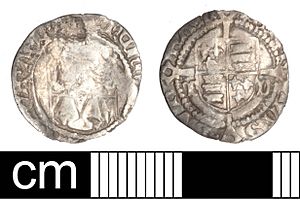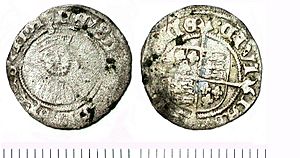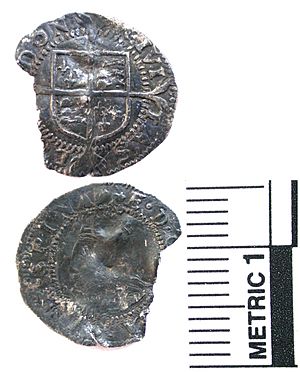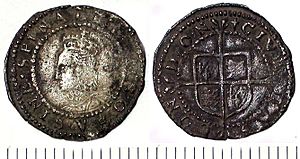History of the English penny (1485–1603) facts for kids
This article tells the story of the English penny coin during the time of the Tudor family, from 1485 to 1603. This period ended when Elizabeth I died. During the Tudor era, kings like Henry VIII and Edward VI made the penny less valuable by mixing less silver into it. This was called debasement. Later, Queen Elizabeth I made the coins good quality again. Over time, the penny also became smaller.
Contents
The Tudor Kings and Queens (1485–1603)
Henry VII's Pennies
Henry VII became king in 1485 after winning the Battle of Bosworth Field. He ruled until 1509. His claim to the throne was not very strong at first. He ended the Wars of the Roses by marrying Elizabeth of York. This brought together the two families that had been fighting.
Henry VII's coins looked very different from older ones. The king's face on the coin looked more real. The shields on the back of the coins were also much more detailed. His first pennies were made in London, Canterbury, Durham, and York. They said HENRIC DI GRA REX ANG, which means Henry by the grace of God King of England.
Soon, Henry made new coins called "Sovereign coinage." On these coins, the king was shown sitting on a throne. The back showed the royal shield over a cross. These coins are seen as a bridge between coins from the Middle Ages and the Renaissance in England. These pennies were made in London, Durham, and York. They had the words HENRICUS DI GRA REX ANG.
Henry VIII's Pennies
Henry VIII's first coins, made until 1526, looked like his father's. They even used his father's picture. Because silver was more expensive in other countries, the weight of English silver coins was reduced. Pennies were made in London, Canterbury, and Durham.
In the 1530s, the king took control of the mints that belonged to churches. From then on, all coin-making places were royal mints. This meant the king got all the money from making coins.
Henry's second set of coins (1526–1544) had a new saying: H.D.G. ROSA SIE SPIA. This means Henry by the grace of God a rose without a thorn. At this time, the way coin weights were measured changed. This made the value of a pennyweight slightly higher. These coins were made in London, Canterbury, Durham, and York.
By 1544, Henry VIII needed more money. This was partly because he spent a lot. So, he made his third set of coins (1544–1547) with much less silver. They were only one-third silver and two-thirds copper. People did not like this. Henry even got the nickname "Old Coppernose" because the silver rubbed off the coin's raised parts, showing the copper underneath. These less valuable coins were made in London, Bristol, Canterbury, and York. They also said H.D.G. ROSA SINE SPINA.
Edward VI's Pennies
When Henry VIII died in 1547, his nine-year-old son, Edward VI, became king. The coins with less silver had caused prices to go up a lot. Also, a lot of silver and gold was coming into Europe from America, which made things even worse.
Until 1551, coins were still made that looked like Henry VIII's last ones, but with a different picture of him. Over the years, the penny had become less important. Other coins like shillings and sixpences were used more often.
Edward VI's reign (1547–1553) was short but important for coins. New types of silver coins were introduced, like the crown, half crown, shilling, sixpence, and threepence. These coins were made of good silver to help the economy. However, Edward VI's pennies were still made with less valuable metal. They were made in London, Bristol, and York. They had the words E.D.G. ROSA SINE SPINA, meaning Edward by the grace of God a rose without a thorn.
Mary I's Pennies
In 1553, Edward VI died. His older sister, Mary, became Queen. Pennies from her first year are quite rare. They show her face and say M.D.G. ROSA SINE SPINA, meaning Mary by the grace of God a rose without a thorn.
In 1554, Queen Mary married Philip, the Prince of Spain. After that, their coins showed both their faces. Both good silver and less valuable pennies were made in London. They had the words P Z M D G ROSA SINE SPINA, meaning Philip and Mary by the grace of God a rose without a thorn.
Elizabeth I's Pennies
When Elizabeth I became Queen in 1558, England was not rich. The coins were in bad shape because of Henry VIII's changes. Elizabeth bravely decided to fix the coin system.
During her time as queen, many gold and silver coins were made. Much of this gold and silver came from raiding Spanish ships. Important silver coins were the shilling and sixpence. But small coins like groats, threepences, half-groats, pennies, and halfpennies were also made. These small coins were very popular with merchants and traders.
For the first time in England, some coins were made by machines. This happened between 1560 and 1572. These "milled" coins were made by a person named Eloy Mestrelle. However, other workers at the mint worried about losing their jobs. This led to Mestrelle being fired. No machine-made pennies were produced because they were too small for the equipment at that time. Also, for the first time, some of Elizabeth's coins had dates on them.
Elizabethan pennies are very small. They are often found bent or creased. The front of the penny shows the queen's face and says E D G ROSA SINE SPINA, meaning Elizabeth by the grace of God a rose without a thorn. The back of the penny says CIVITAS LONDON, meaning City of London. All pennies were made at the Tower mint in London.






